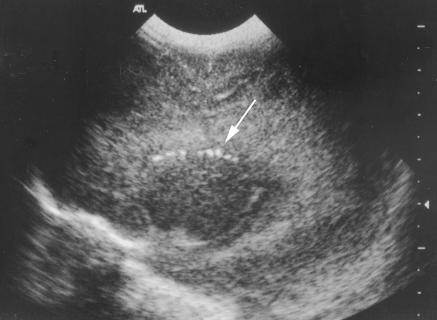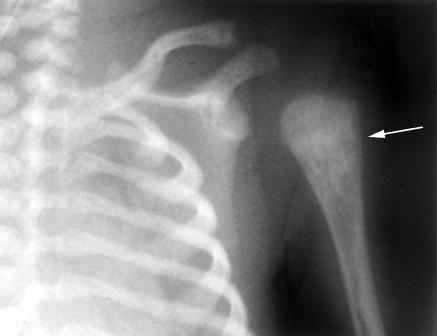Rubella vaccination among schoolgirls and susceptible women in the United Kingdom since 1970 has dramatically reduced the number of cases of congenital rubella syndrome and terminations of pregnancies related to rubella infection.1 In 1988 the combined measles, mumps, and rubella vaccine was introduced for children aged 12-15 months. Reported cases of congenital rubella syndrome declined significantly, with only a few notified cases of infection among immigrants and in infants whose mothers acquired the infection while travelling overseas in early pregnancy. Immune status of pregnant women is determined by routine antenatal screening for rubella IgG antibody, so that susceptible women can receive postpartum vaccination.
We report two infants with congenital rubella syndrome whose mothers had recently arrived from abroad. Both mothers had a rash in early pregnancy in their country of origin, which was not elicited when they booked for antenatal care in the United Kingdom.
Case reports
Case 1
A 22 year old primiparous Sri Lankan woman had routine antenatal screening tests at 20 weeks' gestation, soon after her arrival in the United Kingdom. The laboratory reported presence of rubella IgG antibody, “consistent with immunity.” The infant was born with severe symmetrical intrauterine growth restriction, purpura, thrombocytopenia, and a patent ductus arteriosus. Cranial ultrasonography showed bilateral periventricular calcification (fig 1). Skeletal radiographs showed linear radiolucencies in the metaphyses of the long bones and lucent areas in the iliac bones, consistent with osteitis (fig 2). Ophthalmological examination showed a unilateral cataract on the first day after birth and progressive bilateral cataracts by 3 weeks of age. Congenital rubella syndrome was suspected, and the mother confirmed that she had had a transient rash at 6-8 weeks' gestation in Sri Lanka. Rubella specific IgM was detected in the infant's blood taken at 11 days of age, and excretion of rubella virus was subsequently confirmed in the infant's saliva and urine. Audiological testing showed major bilateral sensorineural hearing loss by 12 weeks. Retesting of the mother's antenatal serum with IgM and IgG avidity tests gave results compatible with acquired rubella infection during early gestation.
Figure 1.
Cranial ultrasound scan showing linear calcification in the brain parenchyma in the parasagittal plane
Figure 2.
Radiograph showing linear radiolucent streaking in the proximal humerus
Case 2
Soon after her arrival in the United Kingdom a 29 year old primiparous Nigerian woman gave birth at 38 weeks' gestation to an infant with severe symmetrical intrauterine growth restriction. The woman's antenatal tests in Nigeria did not include rubella screening. The infant had interstitial pneumonitis, thrombocytopenia, and a patent ductus arteriosus. Ophthalmological examination showed bilateral cataracts by 3 weeks of age. Radiography showed linear streaking of the metaphyses of the long bones. Diagnosis of congenital rubella infection was confirmed by detection of rubella specific IgM in blood at 3 weeks of age. Audiological testing showed moderate sensorineural hearing loss by 8 months of age. The mother confirmed a history of a rash in early gestation, around the time of diagnosis of her pregnancy. Postnatal tests showed the presence of rubella IgG antibody but absence of rubella specific IgM in the mother. These findings are compatible with infection in early pregnancy, as rubella specific IgM in the mother disappears 4-6 weeks after infection.
Discussion
The major reduction in rubella infection since the introduction of measles, mumps, and rubella vaccination is well documented.2–4 However, missed opportunities for vaccination, decreased uptake of the vaccine, reinfection of mothers, and immigration from places where rubella is endemic have contributed to sporadic cases of congenital rubella syndrome in the United Kingdom.
Detection of rubella specific IgG, usually by enzyme linked immunosorbent assay (ELISA), forms the basis of antenatal surveillance for rubella immunity—but the test does not discriminate between vaccine induced immunity and infection acquired during early gestation. In most pregnant women the detection of rubella specific IgG implies immunity following vaccination or infection before pregnancy. However, this result should be interpreted with caution, particularly in recent immigrants from countries where rubella is endemic or where rubella vaccination is not available or not effectively implemented. Racial differences in rubella immunity among pregnant women have been reported. People's exposure to natural infection and to vaccination will vary according to the country where they were brought up. Susceptibility in Asian women has been reported to be four times higher than in non-Asian women.5
Detection of rubella IgG on antenatal screening tests in women who have recently arrived from countries where rubella is endemic may indicate rubella infection acquired in early gestation. Both women in our report had a clear history of a rash in early pregnancy, but this history had not been sought during their antenatal care in the United Kingdom, and the laboratory reported the result of the screening test as “rubella IgG antibody present, consistent with immunity.” Clinicians should actively seek a history of rash in early gestation, particularly in recent immigrants, and the laboratory should be informed of a suspicious history so that the appropriate tests for primary rubella infection can be undertaken. The Public Health Laboratory Services Working Group has outlined advice to be given after these laboratory tests.6 A diagnostic difficulty arises in women tested more than 4-6 weeks after contracting rubella infection in early gestation, as IgM disappears and only IgG antibody is detected in serum. In such cases it is recommended to check past serum samples, if available, for IgG avidity to confirm recent seroconversion. Rarely, IgM positivity may be preceded by IgG positivity when serum is tested within 10 days of infection.
Congenital rubella infection can affect almost all organ systems in the fetus and has a high morbidity and mortality. Typical features of congenital rubella syndrome are cataracts, intrauterine growth restriction, thrombocytopenia, purpura, patent ductus arteriosus, osteitis, and hearing impairment. Microcephaly and chorioretinitis are also common. Periventricular calcification (case 1) has been reported previously in only a minority of infants with congenital rubella syndrome.7 It is more commonly associated with congenital cytomegalovirus and toxoplasma infection.
With the decline in uptake of the measles, mumps, and rubella vaccination, as well as continuing reports of sporadic cases of congenital rubella syndrome, especially among recent immigrants, clinicians need to be aware of the range of clinical manifestations of this infection in pregnant mothers and newborn infants. Early diagnosis of congenital rubella syndrome is important, because infected infants may excrete the virus in urine, saliva, and tears for many months and will be a potential source of infection for non-immune pregnant women. Long term follow up is essential, as cataracts and hearing deficit may not be detectable until some months after birth and progressive deterioration may occur.
Interpret antenatal screening tests for rubella cautiously in recent immigrants and in women with a rash in early pregnancy
Footnotes
Funding: None.
Competing interests: None declared.
References
- 1.Tookey PA, Peckham CS. Surveillance of congenital rubella in Great Britain, 1971-96. BMJ. 1999;318:769–770. doi: 10.1136/bmj.318.7186.769. [DOI] [PMC free article] [PubMed] [Google Scholar]
- 2.Miller E, Waight P, Gay N, Ramsay M, Vurdien J, Morgan-Capner P, et al. The epidemiology of rubella in England and Wales before and after the 1994 measles and rubella immunisation campaign: fourth joint report from the PHLS and the National Rubella Surveillance Programme. Commun Dis Rep CDR Rev. 1997;7:R26–R32. [PubMed] [Google Scholar]
- 3.Sullivan EM, Burgess MA, Forrest JM. The epidemiology of rubella and congenital rubella in Australia, 1992 to 1997. Commun Dis Intell. 1999;23:209–214. [PubMed] [Google Scholar]
- 4.Matter L, Bally F, Germann D, Schopfer K. The incidence of rubella virus infections in Switzerland after the introduction of the MMR mass vaccination programme. Eur J Epidemiol. 1995;11:305–310. doi: 10.1007/BF01719435. [DOI] [PubMed] [Google Scholar]
- 5.Tookey PA, Johnson C, Ades AE, Peckham CS. Racial differences in rubella immunity among pregnant women. Public Health. 1998;102:57–62. doi: 10.1016/s0033-3506(88)80010-6. [DOI] [PubMed] [Google Scholar]
- 6.Morgan-Capner P, Crowcroft N. Report of a Public Health Laboratory Services Working Group. London: Public Health Laboratory Service; 2000. Guidance on the management of, and exposure to, rash illness in pregnancy (including consideration of relevant antibody screening programmes in pregnancy)www.phls.co.uk/advice/rash.pdf (accessed 21 May 2002). [PubMed] [Google Scholar]
- 7.Rowen M, Singer MI, Moran ET. Intracranial calcification in the congenital rubella syndrome. Am J Roentgenol. 1972;115:86. doi: 10.2214/ajr.115.1.86. [DOI] [PubMed] [Google Scholar]




